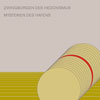Asmus Tietchens, "Zwinburgen Des Hedonismus/Mysterien Des Hafens"
 Die Stadt's reissue program of early Asmus Tietchens' early releases continues into its ninth iteration, this time focusing on two records from the late 1980s. Both differ greatly in their approach and are not equally compelling to these ears.
Die Stadt's reissue program of early Asmus Tietchens' early releases continues into its ninth iteration, this time focusing on two records from the late 1980s. Both differ greatly in their approach and are not equally compelling to these ears.
The disc is broken up into three long pieces, "Zwingburgen des Hedonismus," originally a one sided LP, is very cinematic, featuring early Fairlight sampling experiments focusing on piano and human voice along with sampled strings and wind instruments. It makes for an interesting experiment when placed in the context of its original release (as sampling technology was gaining a wider market), but beyond that it makes for little more than an interesting piece of soundtrack type music.
"Faircomp 1K" is an unreleased track of synthesized brass and string instruments that follow the same structure as "Zwingburgen des Hedonismus." Using a different pallet of sounds, this track calls to mind Carmine Coppolla's synthesized soundtrack to Apocalypse Now both in its analog electronic instrumentation, and sense of tension and fear present in the track. The composition works better when it is in this context as opposed to the sampled instrumentation in "Zwingburgen…"
The final track (two pieces combined) is 1988's "Bubendey Notturno/Ritual auf der Halde," originally appearing on a split record with Die Form entitled Mysterien Des Hafens. The split piece opens with a more traditional electronic synth sequence that continues to build as heavily reverbed and delayed synth lines weave in and around the mix. The last five minutes or so become extremely rhythmic, mimicking the 808 kick drum pulse of so many generic dance tracks, but here placed alongside a dense collage of synth lines that not clearly identifiable. This work feels very much in the vein of the early industrialists such as SPK and Cabaret Voltaire, and even some of the more obscure practitioners such as Maurizio Bianchi and Esplendor Geometrico.
Admittedly, the first track makes for a more interesting piece of experimentation rather than listening, as it does not really manage to keep the interest over time. The second track fares better, but the disc's real high point is the final track, a rhythmic industrial din in the classic sense.
samples:



